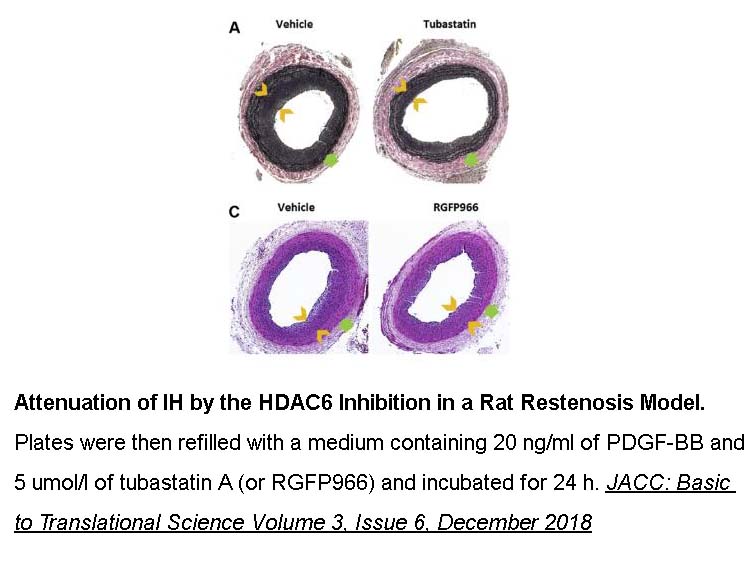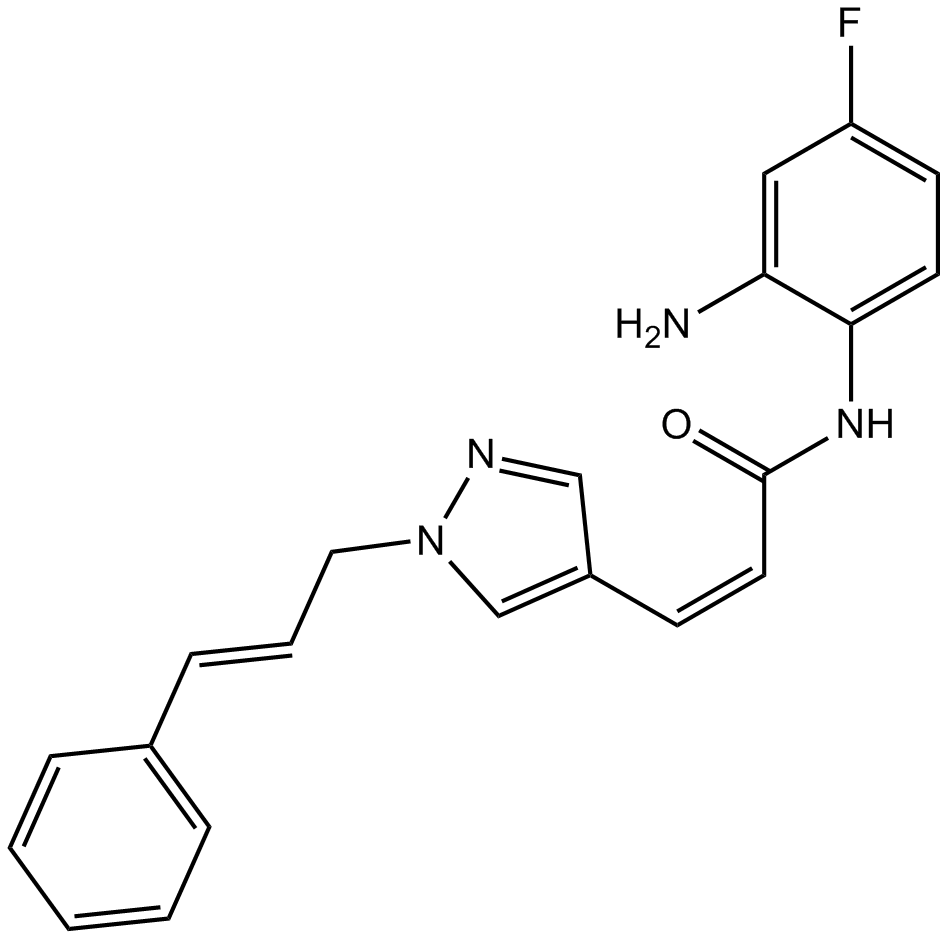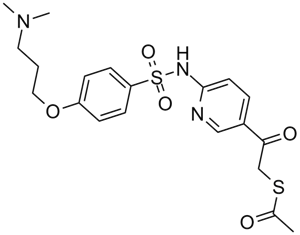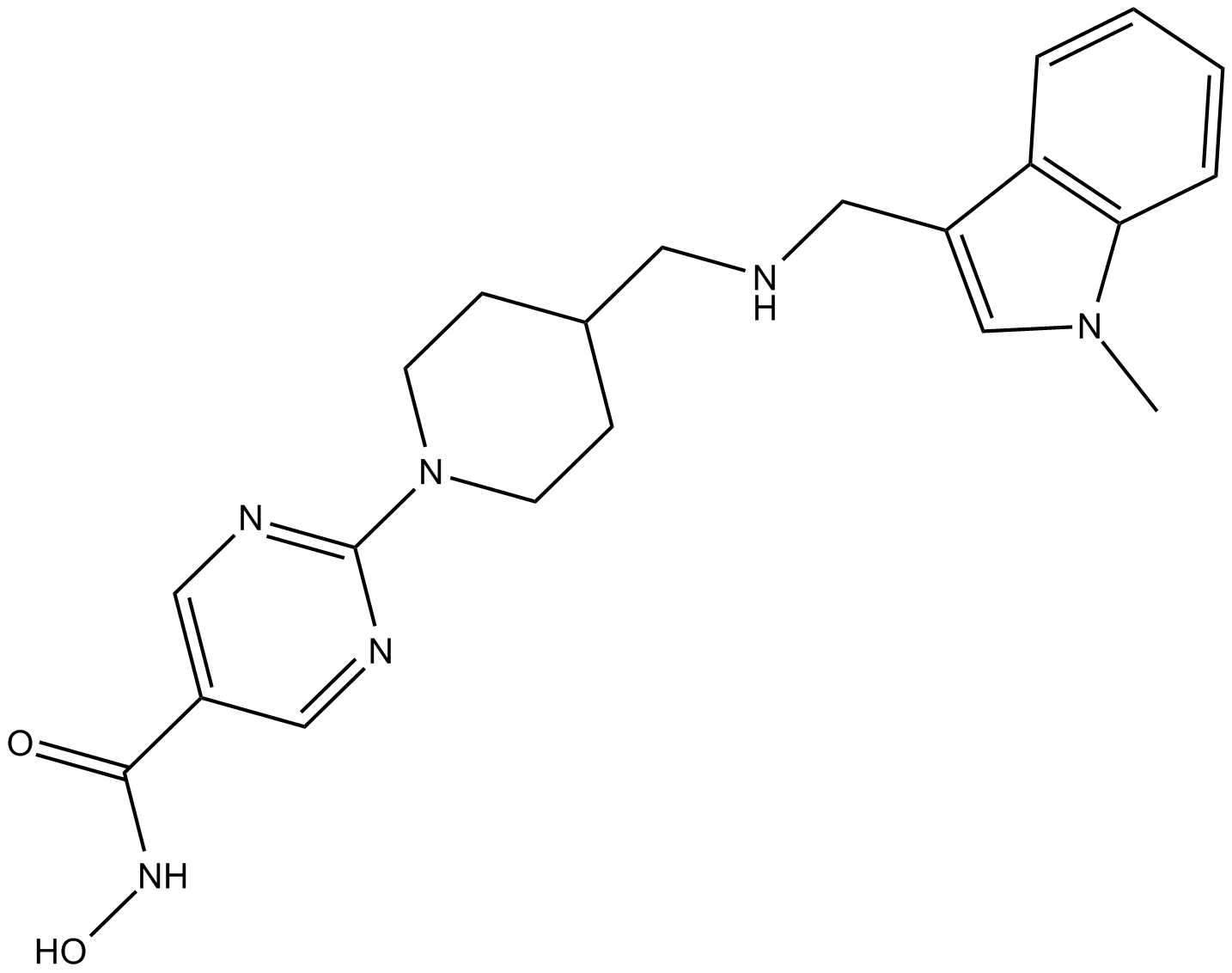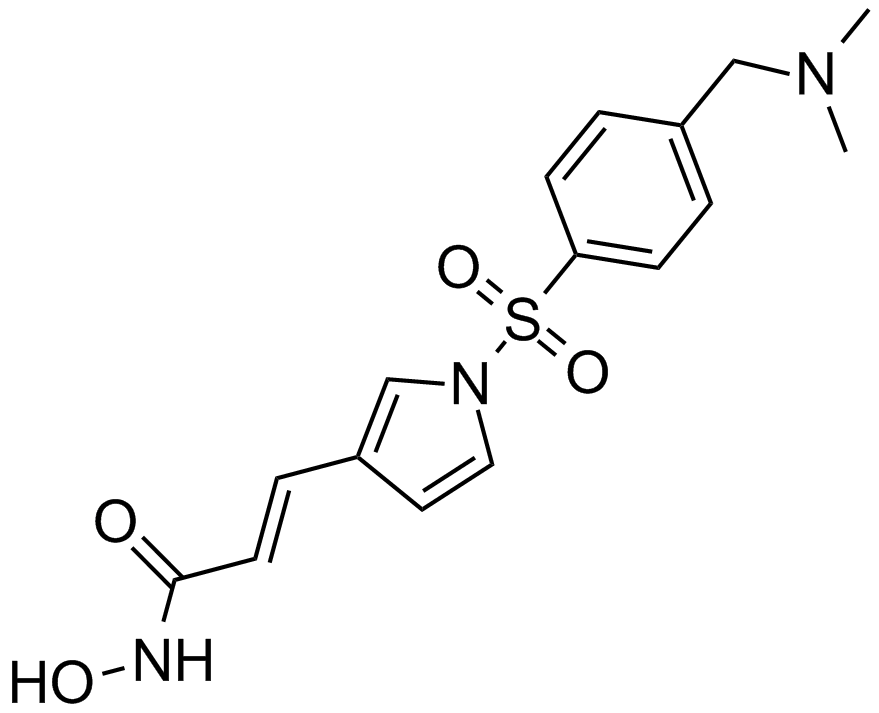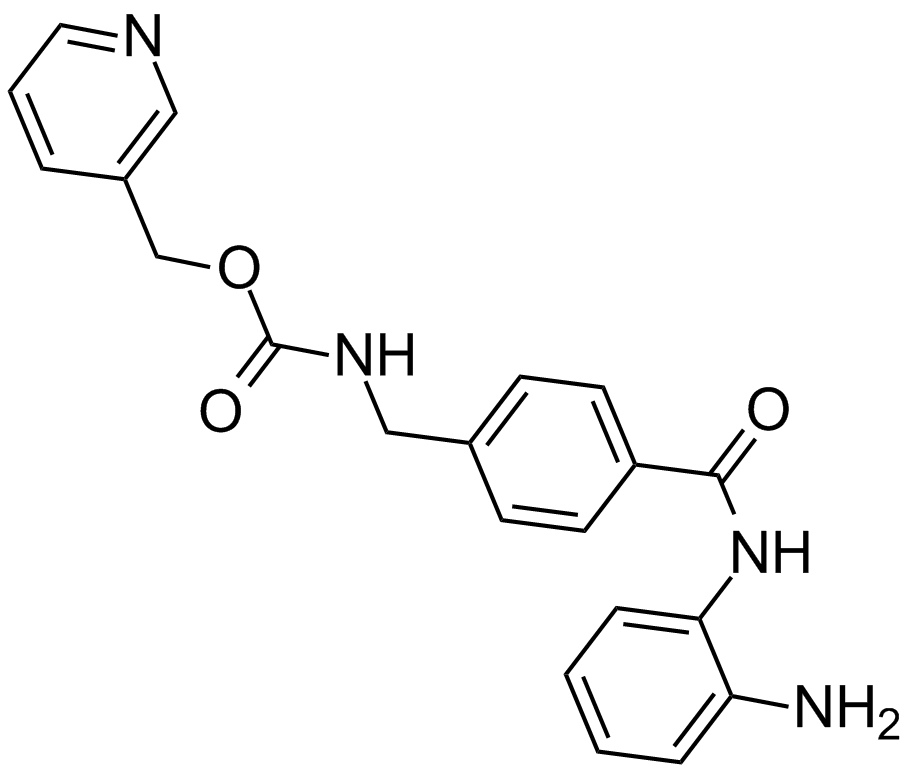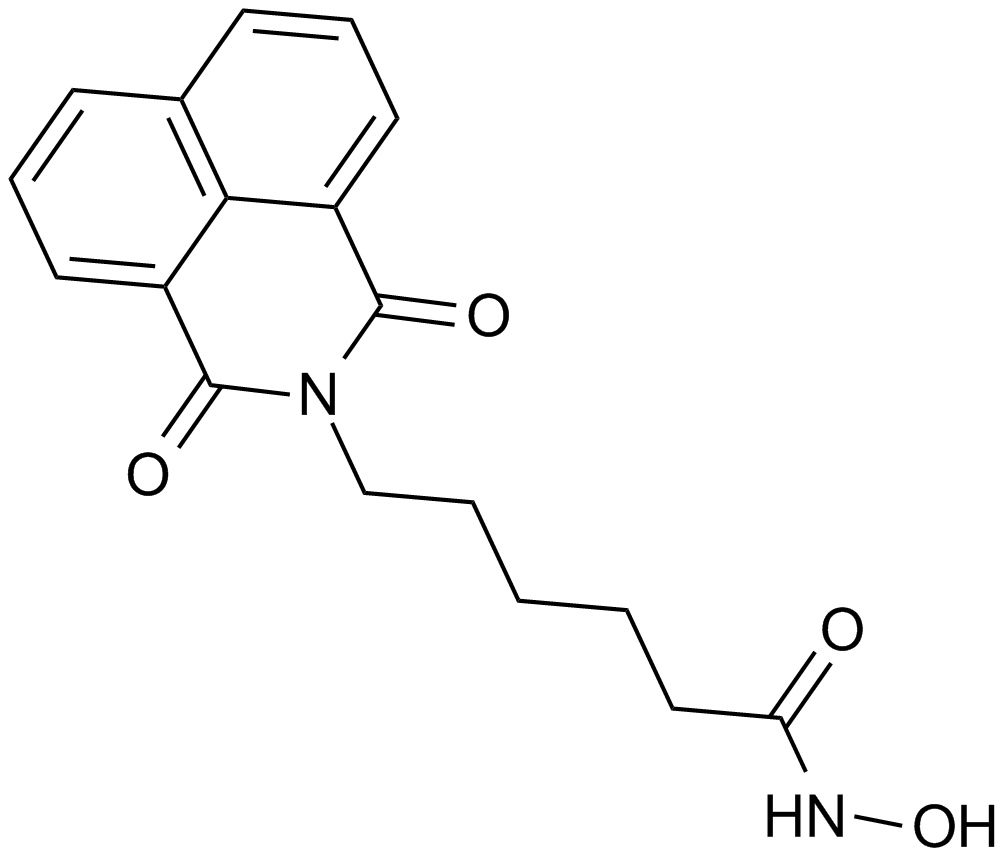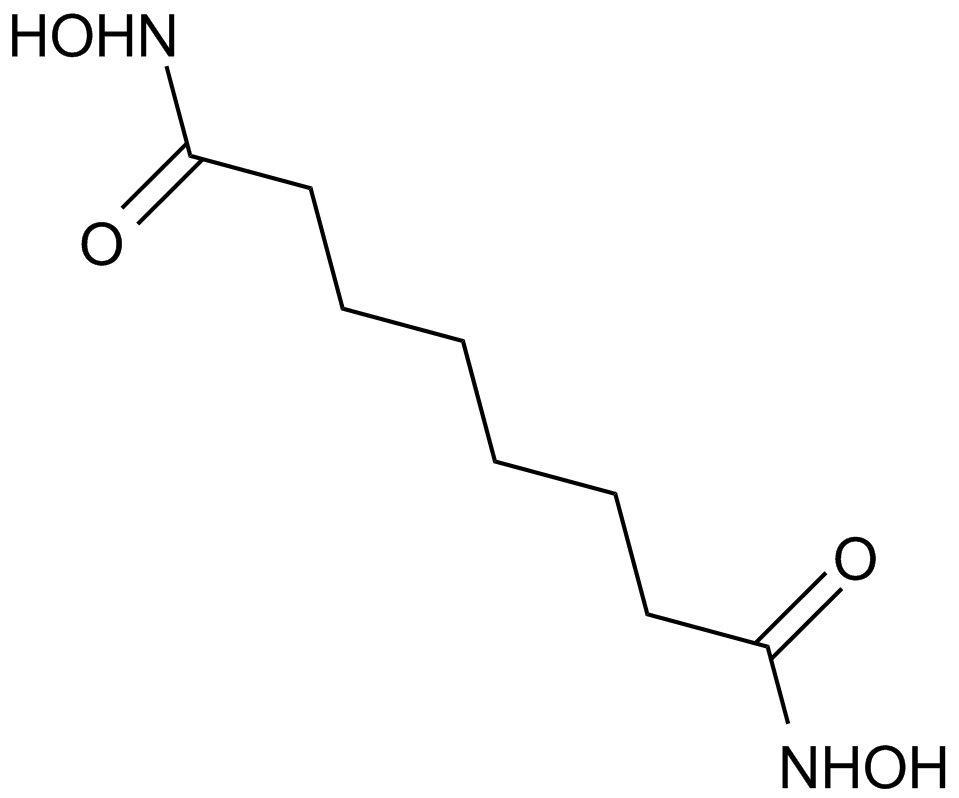RGFP966
RGFP966 is a selective inhibitor of HDAC3 with IC50 value of 80 nM [1].
HDAC3 (histone deacetylase 3) is an isoform of HDACs family and plays an important role in DNA transcriptional regulation. It has been shown that HDACs involves in a variety of biologic processes, like DNA repair, replication, transcription and chromatin structure. Many studies have shown that HDACs is the most highly expressed class I HDAC in the brain and involves in learning and memory process negatively [2].
RGFP966 is a potent HDAC3 inhibitor and has no inhibition on other HDACs at the concentration up to 15 μM. Using a substrate-dependent biochemical assay to investigate RGFP966 inhibition of HDACs, and results showed that it inhibited HDAC3 with IC50 value of 80 nM while had no effective inhibition on other HDACs [1]. When tested with cutaneous T cell lymphoma (CTCL) cell lines with RGFP966, the cell growth were significantly decreased by inhibiting HDAC3 which increased cell apoptosis [3].
In male C57BL/6J mice model, trained them in object recognition (ORM) and location-dependent object recognition (OLM) with a subthreshold period after administration of RGFP966 significantly increased the novel object preference and enhanced enhanced long-term OLM in a dose-dependent manner [1].
References:
[1]. Malvaez, M., et al., HDAC3-selective inhibitor enhances extinction of cocaine-seeking behavior in a persistent manner. Proc Natl Acad Sci U S A, 2013. 110(7): p. 2647-52.
[2]. Rogge, G.A., et al., HDAC3 is a negative regulator of cocaine-context-associated memory formation. J Neurosci, 2013. 33(15): p. 6623-32.
[3]. Wells, C.E., et al., Inhibition of histone deacetylase 3 causes replication stress in cutaneous T cell lymphoma. PLoS One, 2013. 8(7): p. e68915.
- 1. Joseph Boyle, Derick Chiappo, et al. "Aminocoumarin-based heme oxygenase activity fluorescence probe reveals novel aspects of HO-1 regulation." Research Square. 22 Nov, 2023.
- 2. Junrong Yang, Ning Zhang, et al. "Dynamic Effects of Ketogenic Diet on Autophagy and Cell Cycle in a Mouse Model of CT26+ Colon Cancer" Pakistan J. Zool. 28 July 2023.
- 3. "HDAC6 Regulates the MRTF-A/SRF Axis and Vascular Smooth Muscle Cell Plasticity." JACC Basic Transl Sci. 2018 Dec 31;3(6):782-795. PMID:30623138
- 4. "Elimination of HIV-1 Latently Infected Cells by Gnidimacrin and a Selective HDAC Inhibitor." ACS Med Chem Lett. 2018 Feb 6;9(3):268-273. PMID:29541372
- 5. "Epigenetic Therapy Ties MYC Depletion to Reversing Immune Evasion and Treating Lung Cancer." Cell. 2017 Nov 30;171(6):1284-1300.e21. PMID:29195073
- 6. "Novel histone deacetylase inhibitor N25 exerts anti-tumor effects and induces autophagy in human glioma cells by inhibiting HDAC3."Oncotarget. 2017 Sep 8;8(43):75232-75242. PMID:29088860
| Storage | Store at -20°C |
| M.Wt | 362.4 |
| Cas No. | 1357389-11-7;1396841-57-8 |
| Formula | C21H19FN4O |
| Synonyms | RGFP 966;RGFP-966 |
| Solubility | insoluble in H2O; ≥18.12 mg/mL in DMSO; ≥2.94 mg/mL in EtOH with ultrasonic |
| SDF | Download SDF |
| Canonical SMILES | Nc(cc(cc1)F)c1NC(C=Cc1c[n](CC=Cc2ccccc2)nc1)=O |
| Shipping Condition | Small Molecules with Blue Ice, Modified Nucleotides with Dry Ice. |
| General tips | We do not recommend long-term storage for the solution, please use it up soon. |
| Kinase experiment [1]: | |
|
Deacetylation assays |
Deacetylation assays were based on the homogenous fluorescence release assay. Purified recombinant enzymes were incubated with serial-diluted inhibitors at the indicated concentrations, with pre-incubation periods ranging from 0 to 3 hrs, in the standard HDAC buffer. Acetyl-Lys(Ac)-AMC substrate (at 10 μM, corresponding to the Km for both HDAC1 and HDAC3) was added after the pre-incubation period. The reaction was allowed to run for 1 hr. The trypsin peptidase developer, at final concentration of 5 mg/mL, was added after 1 hr, and the fluorescence emission was then measured using a Tecan M200 96-well plate reader. |
| Cell experiment [2]: | |
|
Cell lines |
HH and Hut78 CTCL cells |
|
Preparation method |
The solubility of this compound in DMSO is > 18.1 mg/mL. General tips for obtaining a higher concentration: Please warm the tube at 37 °C for 10 minutes and/or shake it in the ultrasonic bath for a while. Stock solution can be stored below - 20 °C for several months. |
|
Reacting condition |
~ 10 μM; 24 ~ 72 hrs |
|
Applications |
In HH and Hut78 CTCL cells, the 24-hr RGFP966 treatment increased the acetylation of H3K9/K14, H3K27, and H4K5, but not H3K56ac. In addition, RGFP966 also inhibited the growth of CTCL cells by increasing apoptosis that was related to DNA damage and impaired S phase progression. |
| Animal experiment [1]: | |
|
Animal models |
C57BL/6J mice |
|
Dosage form |
3, 10 and 30 mg/kg; systemic delivery |
|
Applications |
After ORM training, RGFP966 significantly increased preference for the novel object in a dose-dependent manner. Mice treated with 10 mg/kg RGFP966 either 1 hr before or after subthreshold OLM training showed enhanced preference for the object in a novel location during the retention test, without any effect on the total exploration time of objects. |
|
Other notes |
Please test the solubility of all compounds indoor, and the actual solubility may slightly differ with the theoretical value. This is caused by an experimental system error and it is normal. |
|
References: [1]. Malvaez, M., et al., HDAC3-selective inhibitor enhances extinction of cocaine-seeking behavior in a persistent manner. Proc Natl Acad Sci U S A, 2013. 110(7): p. 2647-52. [2]. Wells, C.E., et al., Inhibition of histone deacetylase 3 causes replication stress in cutaneous T cell lymphoma. PLoS One, 2013. 8(7): p. e68915. |
|
| Description | RGFP966 is a specific inhibitor of HDAC3 with an IC50 value of 0.08 μM. | |||||
| Targets | HDAC3 | |||||
| IC50 | 0.08 μM | |||||
Quality Control & MSDS
- View current batch:
Chemical structure
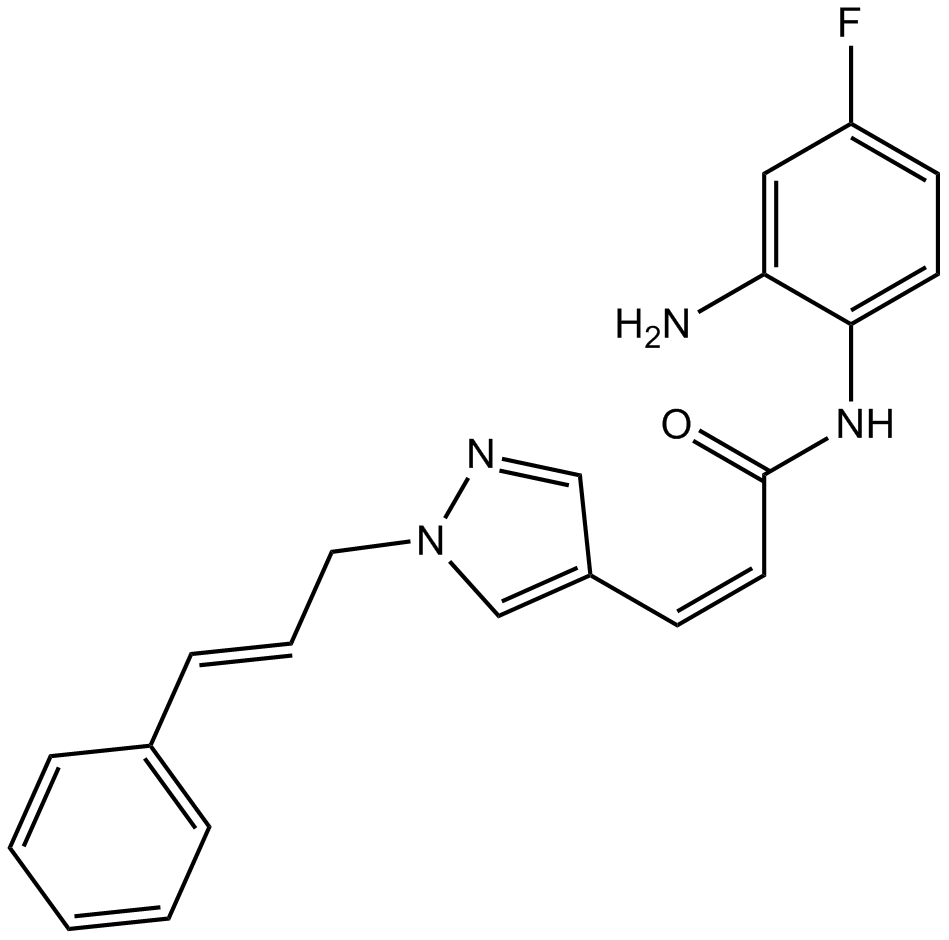
Related Biological Data
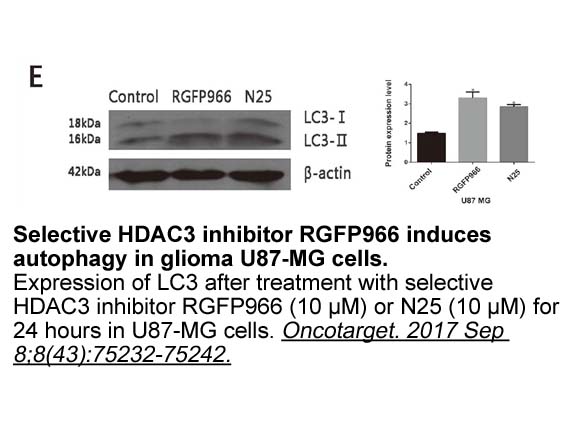
Related Biological Data
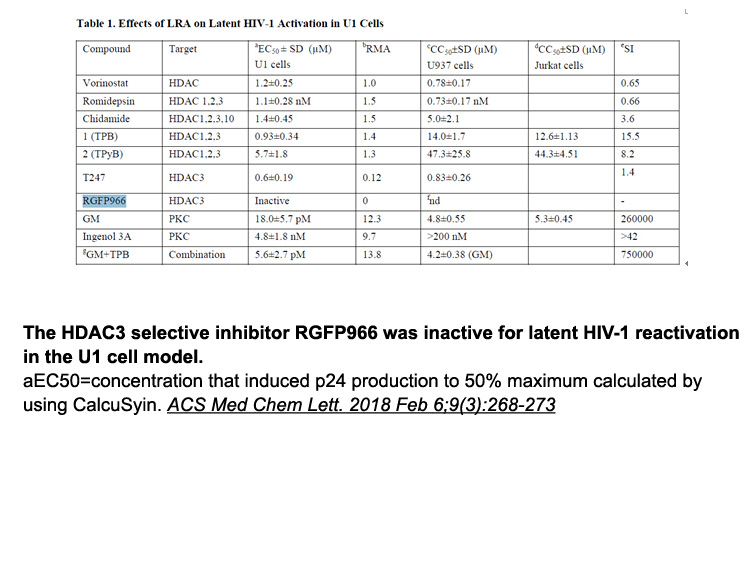
Related Biological Data
